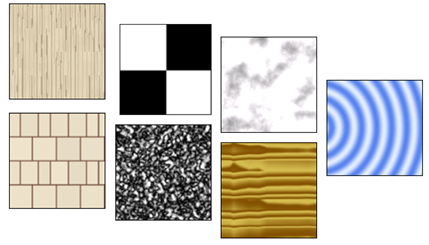Procedural maps add further realism to a material.
Unlike bitmap images, which are produced by a fixed matrix of colored pixels like a mosaic, a procedural map is generated by a mathematical algorithm. Consequently, the types of controls you might find for a procedural map will vary depending on the capabilities of the procedure. A procedural map can be generated in two dimensions, or in three. You can also nest additional texture or procedural maps within a procedural map to add to depth and complexity to the material.

Examples of procedural maps with variations. Top row: Marble, Checker, Speckle and Waves. Bottom row: Tiles, Noise and Wood.
Checker applies a two-color checkerboard pattern to the material.
Applies a stone color and vein color pattern.
Creates random perturbation of a surface based on the interaction of two colors, texture maps or combination.
Generates a speckled surface pattern.
Applies a brick or stacked tiling of colors or material mappings.
Simulates water or wave effects.
Creates the color and grain pattern of wood.